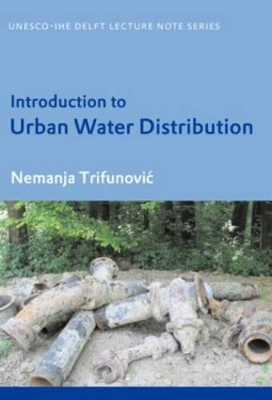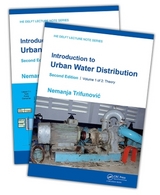
Introduction to Urban Water Distribution
Taylor & Francis Ltd (Verlag)
978-0-415-39517-5 (ISBN)
- Titel erscheint in neuer Auflage
- Artikel merken
Focusing primarily on understanding the steady-state hydraulics that form the basis of hydraulic design and computer modelling applied in water distribution, Introduction to Urban Water Distribution elaborates the general principles and practices of water distribution in a straightforward way. The workshop problems and design exercise develop a temporal and spatial perception of the main hydraulic parameters in the system for given layout and demand scenarios. Furthermore, the book contains a detailed discussion of water demand, which is a fundamental element of any network analysis, and principles of network construction, operation, and maintenance. The attached CD contains all spreadsheet applications mentioned in the text, and the network model used in the design exercise. Written in a manner that is easily understood by those who know little about the subject, this introductory text will also benefit experts dealing with advanced problems who wish to refresh their knowledge.
Nemanja Trifunovic is Associate Professor of Water Supply at UNESCO-IHE Institute for Water Education in Delft, the Netherlands. He is a specialist in the field of water transport and distribution in general, and in application of computer models in urban distribution networks in particular. He has worked extensively in Africa, Asia and the Middle East.
Preface, Learning Method,
1. Water Transport and Distribution Systems; Introduction, Definitions & objectives: Transport and distribution; Piping; Storage; Pumping; Types of distribution schemes; Network configurations.
2. Water Demand:Terminology; Consumption categories: Domestic consumption; Non-domestic consumption; Water demand patterns: Instantaneous demand; Diurnal patterns; Periodic variations; Demand calculation; Demand forecasting; Demand frequency distribution.
3. Steady Flows in Pressurised Networks: Main concepts & definitions: Conservation laws; Energy & hydraulic grade lines; Hydraulic losses: Friction losses; Minor losses; Single pipe calculation: Pipe pressure; Maximum pipe capacity: Required diameter: Pipe charts & tables; Equivalent diameters; Serial & branched networks: Supply at one point; Supply at several points; Looped networks: Hardy Cross Methods; Linear theory; Pressure related demand; Hydraulics of storage & pumps: System characteristics; Gravity systems; Pumped systems: Combined systems.
4. The Design of Water Transport and Distribution Systems: The planning phase: the design period; Economic aspects; Hydraulic design: Design criteria; Basic design principles; Storage design; Pumping station design; Computer models as design tools: Input data collection; Network schematisation; Model building; Nodal demands; Model testing: Problem analysis; Hydraulic design of small pipes: Equivalence Method; Statistical methods; Engineering design: Pipe materials; Joints; Fittings; Valves; Water meters; Fire hydrants; Service connections; Indoor installations; Design of storage and pumping stations; Standardisation & Quality Assessment.
5. Network Construction: Site preparation: Excavation; Trench dewatering; Pipe laying; Laying in trenches; Casings; Laying above ground; Pipe jointing: Flanged joints; Gland joints; ‘Push-in’ joints; Anchorages & supports; Backfilling; Testing & disinfection.
6. Operation and Maintenance: Network operation: Monitoring; Network reliability; Unaccounted-for water & leakage; Corrosion; Network maintenance: Planning of maintenance; Pipe cleaning; Animal disinfection; Pipe repairs; Organisation of water company: Tasks; Mapping; Structure & size; example.
Appendices: 1. Workshop Problems: Water demand; Single pipe calculation; Branched systems; Looped systems; Hydraulics of storage & pumps. 2. Design Exercise: Case introduction: Safi town; Questions; Hydraulic design; System operation; Final layouts; Alternative A; Direct pumping; Alternative B - Pumping & balancing storage; Phased development; Cost analyses; Summary & conclusions. 3. Minor Loss Factors: Bends & elbows; Enlargements & reducers; Branches; Inlets & outlets; Flow meters; Valves; 4. Hydraulic Tables, D = 50 -1600mm, S = 0.0005 – 0.02; k = 0.01, 0.05, 0.1, 0.5, 1 & 5 mm at T = 10º C;k = 0.01, 0.05, 0.1, 0.5, 1 & 5 mm at T = 20º C.5. Spreadsheet Hydraulic Lessons: Overview: Single pipe calculation; Pipes in parallel & series; Branched network layouts; Looped network layouts; Gravity supply; Pumped supply; Combined supply; Water demand. 6. EPANET Instructions for use; Installation;;Using the programme; Input data; Viewing results; Error & warning messages; Troubleshooting results.
7. Unit Conversion Table; References; Index.
| Erscheint lt. Verlag | 9.3.2006 |
|---|---|
| Reihe/Serie | IHE Delft Lecture Note Series |
| Verlagsort | London |
| Sprache | englisch |
| Maße | 174 x 246 mm |
| Gewicht | 1179 g |
| Themenwelt | Technik ► Bauwesen |
| Technik ► Umwelttechnik / Biotechnologie | |
| ISBN-10 | 0-415-39517-8 / 0415395178 |
| ISBN-13 | 978-0-415-39517-5 / 9780415395175 |
| Zustand | Neuware |
| Haben Sie eine Frage zum Produkt? |
aus dem Bereich



